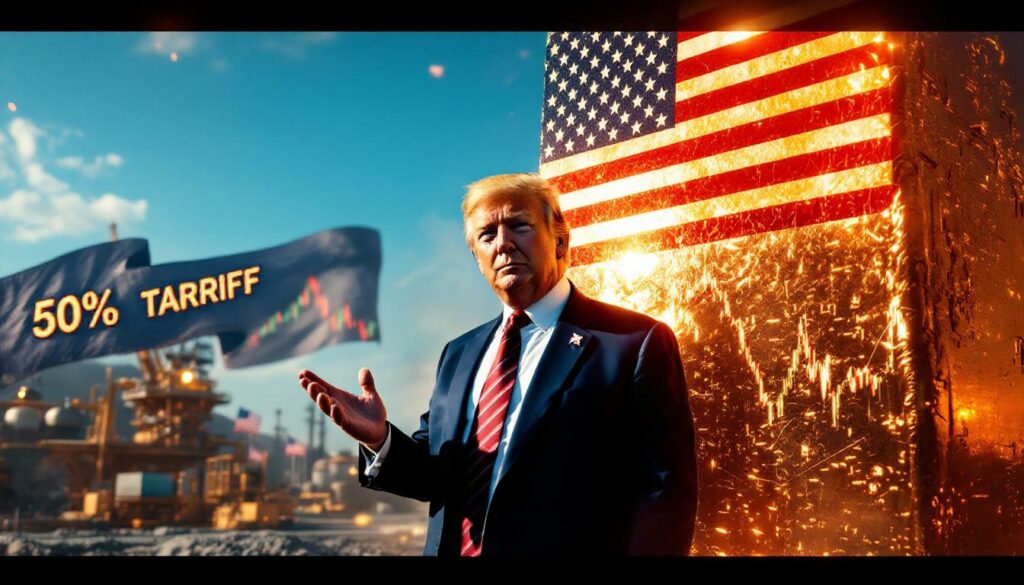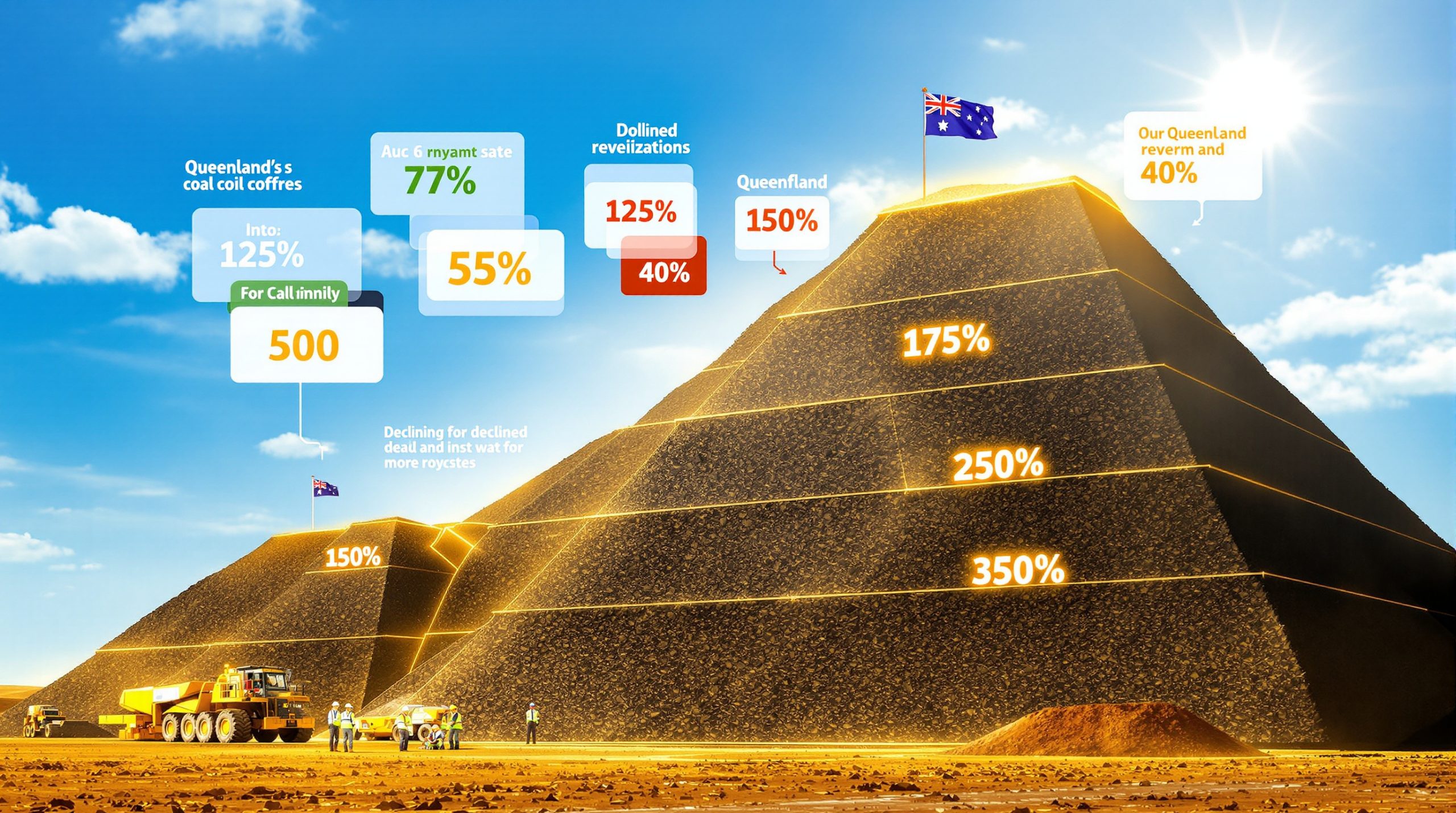What Are the Trump Administration's Copper Tariffs?
The Trump administration's decision to implement a 50% tariff on copper imports represents one of the most aggressive trade actions targeting critical industrial metals in recent memory. This substantial tariff has created immediate ripples throughout global commodity markets, affecting everything from manufacturing costs to investment strategies.
Understanding the Tariff Announcement
The copper tariff announcement came with minimal lead time—announced in July with an effective date of August 1st, giving market participants less than a month to prepare. As Lobo Tiggre of Independent Speculator noted in a Palisades Gold Radio interview: "This produced a scramble that took copper prices to all-time highs. But that's US copper prices."
This compressed timeline between announcement and implementation created what economists call a "rush to the gate" effect, where importers scrambled to secure supplies before the deadline, triggering significant price movements in domestic markets.
Key Features of the Copper Tariff Policy
The tariffs represent a significant shift in trade policy for essential industrial metals. Key aspects include:
- 50% tax rate on imported copper
- Less than 30-day implementation window
- Targeting of a metal essential to manufacturing and infrastructure
- Part of a broader critical minerals strategy
- Paid by U.S. importers rather than foreign producers
This policy approach signals a fundamental shift toward prioritizing domestic resource security over traditional free trade principles.
How Tariffs Function in Global Commodity Markets
A critical point often misunderstood in public discourse is that tariffs are taxes paid by domestic importers—not foreign producers. Tiggre emphasized this clearly: "A US tariff… the importers, the US importers pay that tariff… so this 50% tax on copper is being paid by American copper users."
This economic reality means that while designed to protect domestic industries, tariffs initially create higher input costs for American manufacturers, construction companies, and other copper users. The long-term strategy appears to be encouraging domestic production, though market adjustments occur through complex global supply chains.
How Have Copper Markets Responded to the Tariffs?
Immediate Price Impact in U.S. Markets
The announcement triggered immediate and dramatic price responses in U.S. copper markets. As importers rushed to secure supplies before the August 1st deadline, domestic copper prices surged to record highs. This price spike demonstrated the power of policy announcements to create significant short-term market distortions.
What makes this particularly noteworthy is that the price effect was largely confined to the U.S. market, creating a divergence that reveals how regional policies can fragment global metal markets impact.
The "Alligator Jaws" Price Divergence
One of the most fascinating market phenomena to emerge from the tariff announcement is what industry insiders call the "alligator jaws" effect—a vivid description of how U.S. and international copper prices diverged dramatically following the announcement.
Tiggre described this effect clearly: "The alligator jaws just opened. US copper went up and actually London copper… was cheaper than it was a year ago." This price divergence between domestic and London Metal Exchange (LME) benchmark prices illustrates the regionalization of what had been a globally uniform commodity price.
Inventory Shifts and Global Redistribution
The tariff announcement triggered notable changes in copper inventory movements across the global supply chain. Initially, copper shipments were redirected to U.S. ports to beat the tariff deadline, creating temporary inventory drawdowns in some regions.
Once the pre-tariff window closed, however, market participants observed a rebalancing effect. As Tiggre noted, "inventories are starting to build overseas again," suggesting that the global market was adjusting to the new trade reality by redirecting copper flows away from the U.S. toward markets without comparable tariffs.
Why Impose Tariffs on Essential Industrial Metals?
Revenue Generation Versus Strategic Objectives
There are multiple lenses through which to view the copper tariffs. On a straightforward fiscal level, they generate government revenue. As Tiggre observed: "On one level, you could look at the copper thing as about tariffs, at least about revenue, right? We've just given all these tax breaks… You know, we need to balance the budget somehow."
Copper's essential nature means demand remains relatively inelastic in the short term, making it a reliable revenue source. However, the strategic motivations likely extend far beyond simple revenue collection.
The "Fortress America" Strategic Framework
A more comprehensive interpretation views these tariffs as part of what analysts have termed a "Fortress America" strategy—a policy framework focused on strengthening domestic industrial capacity and reducing foreign dependencies.
Tiggre articulated this perspective: "I think Trump is trying… fortress America first. I think Trump is looking out over the 21st century." This approach prioritizes:
- Rebuilding domestic manufacturing capabilities
- Securing supply chains for critical materials
- Strengthening defense-adjacent industries
- Reducing dependence on potential geopolitical rivals
This strategic framework represents a significant departure from decades of globalization-focused trade policy.
Critical Minerals and National Security
The administration has explicitly linked critical minerals to national security concerns through executive orders on expedited permitting. Notably, these orders have included not just traditional strategic metals but also monetary metals.
As Tiggre highlighted: "He specifically included gold on that list… He did include uranium mining policy shift." This inclusion signals a broader definition of strategic resources that extends beyond traditional industrial inputs to encompass energy metals and even monetary metals.
What Are the Economic Implications of Copper Tariffs?
Short-Term Price Effects Versus Long-Term Market Adjustments
While the immediate price effects have been dramatic, global commodity markets typically find equilibrium through supply chain adjustments. Copper, being what Tiggre calls "a globally fungible commodity" with "more value by weight than oil," can be redirected through global supply chains to circumvent trade barriers.
The key question facing market participants is whether these temporary price distortions will evolve into structural market changes or whether global arbitrage will eventually narrow the price gap between U.S. and international markets.
Impact on U.S. Manufacturing Competitiveness
One potential unintended consequence of copper tariffs is reduced competitiveness for U.S. manufacturers. With approximately 50% of U.S. copper needs currently met through imports, domestic manufacturers using copper as an input face increased costs compared to international competitors.
This creates a paradox where policies designed to strengthen manufacturing independence may initially weaken the competitive position of the very industries they aim to protect. The long-term success depends on whether domestic production can scale up to meet demand at competitive prices.
Global Supply Redistribution Effects
The tariffs may not reduce global copper supply but rather redistribute it. Copper previously destined for U.S. markets may be redirected to other regions, potentially creating oversupply conditions and price pressure in non-U.S. markets.
"When you raise the price of something here, you get less of it coming here. So yes, that means more of it going elsewhere, which can actually depress prices elsewhere."
— Lobo Tiggre
This highlights how protectionist policies can create unexpected consequences in interconnected global markets, including potentially helping manufacturing competitors in other regions access cheaper copper inputs.
How Might Domestic Copper Production Respond?
Current State of U.S. Copper Production
The United States currently imports approximately 50% of its copper needs, highlighting a significant dependency on foreign sources. Domestic production has faced challenges from mining permitting challenges, environmental regulations, and economic factors that have limited new mine development.
The tariff policy appears designed to address this gap by incentivizing domestic production through higher price points for U.S. copper.
Permitting Reform and Regulatory Changes
The administration has paired tariffs with efforts to streamline permitting for critical mineral projects. Executive orders have directed federal agencies to expedite reviews and reduce regulatory barriers for copper and other strategic minerals.
Industry participants have reported observable changes in regulatory agency behavior. As Tiggre noted, "My sources on the ground in the U.S. west… they can see it, they see the different behavior from the BLM and the forestry service types." This suggests the policy approach extends beyond just tariffs to address regulatory barriers to domestic production.
Realistic Timelines for New Production
Despite regulatory reforms, the reality of mining development timelines means that tariffs cannot trigger immediate production increases. Tiggre emphasized this challenge: "Even if you get the permit, you still take years to build."
The development timeline for new copper mines typically includes:
- Exploration and resource definition: 2-5 years
- Feasibility studies and financing: 2-3 years
- Permitting: 3-7 years (potentially expedited under new policies)
- Mine construction: 3-5 years
- Ramp-up to full production: 1-2 years
This creates a significant gap between policy implementation and potential domestic supply response, meaning tariffs will likely affect prices for years before substantial new production comes online.
Investment Decision Challenges
Mining companies face difficult investment decisions when considering new U.S. copper projects. As Tiggre noted, "These are multi-billion dollar projects. These are projects with 30-40-year mine lives, you know, 5-10 billion in capex."
With such massive capital requirements and decades-long investment horizons, companies must evaluate policy stability beyond any single administration. This creates hesitancy even with favorable current policies, as investors must consider the potential for policy reversal under future administrations.
How Do Copper Tariffs Fit Into Broader Economic Strategy?
Relationship to Manufacturing and Infrastructure Initiatives
The Trump administration copper tariffs appear connected to broader initiatives to rebuild U.S. manufacturing capacity and upgrade infrastructure. Both objectives require substantial copper inputs, with infrastructure particularly dependent on copper for electrical systems, plumbing, and telecommunications.
This creates a delicate balance where policies must support both domestic mineral production and the industries that depend on those minerals as inputs.
Comparison to Other Critical Mineral Policies
The administration has targeted multiple critical minerals with similar policy approaches. The executive orders on expedited permitting mentioned by Tiggre include not just copper but also:
- Uranium for energy security
- Rare earth elements for technology manufacturing
- Gold, suggesting monetary and financial security concerns
- Various battery metals essential for electrification
This multi-mineral approach suggests a comprehensive resource strategy rather than a copper-specific policy.
International Response and Potential Retaliation
The global nature of commodity markets means unilateral actions often prompt multilateral responses. Trading partners may respond with countermeasures that could impact other U.S. exports or trigger broader trade tensions.
The risk of escalating trade disputes adds another layer of complexity to evaluating the long-term effectiveness of copper tariffs as an industrial policy tool.
What Are the Investment Implications of Copper Tariffs?
Opportunities in Domestic Copper Projects
U.S.-based copper projects potentially benefit from both higher domestic prices and regulatory streamlining. However, investors must carefully evaluate:
- Project timelines versus policy horizons
- Capital requirements and financing challenges
- Technical feasibility and grade considerations
- Potential for policy reversal under future administrations
Tiggre noted that "most of the big copper projects in the U.S. are, I'm not even sure how many are at the feasibility stage yet," highlighting the early-stage nature of many potential domestic copper sources.
Broader Commodity Investment Considerations
The strategic focus on critical minerals suggests potential opportunities beyond copper alone. The "Fortress America" framework, if sustained, could support long-term demand for:
- Energy metals (uranium, copper, nickel)
- Infrastructure materials (steel, aluminum)
- Technology metals (rare earths, lithium)
- Monetary metals (gold, silver)
Investors seeking exposure to this policy trend might consider diversification across multiple strategic resource categories rather than focusing solely on copper price predictions.
Risk Management in Policy-Driven Markets
Investors face challenges navigating markets significantly influenced by policy decisions rather than traditional supply-demand fundamentals. The tariff-induced price divergence between U.S. and international copper markets illustrates how policy can temporarily override fundamentals.
Effective strategies might include:
- Diversification across multiple commodities
- Focus on producers with existing operations
- Consideration of global market dynamics beyond U.S. policy
- Attention to company-specific factors beyond macro trends
How Might Global Copper Markets Evolve?
Potential for Market Fragmentation
The tariffs could contribute to a fragmentation of global commodity markets, with regional pricing differences becoming more pronounced. This would represent a significant shift from the highly globalized commodity markets that have characterized recent decades.
Such fragmentation creates both risks and opportunities for market participants, requiring more sophisticated approaches to trading, hedging, and physical supply management.
Supply Chain Restructuring Possibilities
Companies may restructure supply chains to navigate the new tariff environment, potentially:
- Relocating manufacturing to access lower-cost copper
- Developing alternative sourcing strategies
- Creating more complex trade flows to minimize tariff impacts
- Investing in recycling and material efficiency
These adjustments may eventually blunt the intended effects of tariffs as global supply chains adapt to the new reality.
Long-Term Price Discovery Challenges
Market participants face increased complexity in price discovery as policy factors complicate traditional supply-demand analysis. The divergence between U.S. and international prices creates challenges for hedging strategies and contract pricing mechanisms.
This complexity may lead to increased market volatility and wider bid-ask spreads as participants adjust to a multi-tiered global pricing environment.
What's the Geopolitical Context of Copper Tariffs?
Global Remilitarization Trends
The copper tariffs exist within a broader context of increased defense spending and industrial policy globally. Major powers including Europe, Russia, and China are all expanding military capabilities and securing supply chains for critical materials, creating a reinforcing cycle of strategic competition.
Copper's essential role in defense applications—from electronics to communications systems—makes it a natural target for strategic resource policies.
Central Bank Gold Buying and Monetary Shifts
Parallel developments in monetary metals markets, particularly accelerated central bank gold purchases, suggest a broader restructuring of the international economic order. Tiggre's observation that gold was specifically included in critical minerals executive orders hints at this connection between resource security and monetary security.
These trends align with the strategic minerals focus as nations seek both physical and financial security in an increasingly uncertain global environment.
BRICS Nation Responses
The BRICS nations (Brazil, Russia, India, China, South Africa) and their expanding partnership network may accelerate alternative trade arrangements in response to U.S. tariff policies. This could include development of non-dollar commodity trading mechanisms and strategic resource partnerships.
Such developments would further fragment global commodity markets and potentially reduce the effectiveness of unilateral trade policies over time.
FAQs About Trump Administration Copper Tariffs
Will copper tariffs actually increase domestic production?
While tariffs create economic incentives for domestic production, the lengthy development timelines for new copper mines mean significant production increases would take 5-10 years even with expedited permitting. As Tiggre noted, "Even if you get the permit, you still take years to build." The policy may be more effective at preserving existing production than stimulating new supply in the short term.
How do copper tariffs affect everyday consumers?
Consumers may experience indirect price increases in products containing significant copper content, including electrical equipment, plumbing fixtures, air conditioning systems, and electronic devices. The distributed nature of these costs makes them less visible than direct consumer tariffs, but they ultimately flow through to end users.
Are the copper tariffs likely to remain in place long-term?
Policy durability depends on multiple factors including political developments, economic impacts, international responses, and effectiveness in achieving stated objectives. The capital-intensive nature of mining suggests industry participants will seek policy stability before making major investment decisions, creating pressure for policy continuity.
How do these tariffs compare to previous metals tariffs?
The 50% rate exceeds most previous metals tariffs in recent history. This aggressive rate signals the strategic importance placed on copper and suggests a willingness to accept short-term economic disruption in pursuit of longer-term strategic objectives.
Could tariffs actually decrease global copper prices?
Paradoxically, by redirecting copper away from U.S. markets, the tariffs could create oversupply conditions in other regions, potentially suppressing prices in non-U.S. markets. As Tiggre observed, "When you raise the price of something here, you get less of it coming here. So yes, that means more of it going elsewhere, which can actually depress prices elsewhere." This highlights the complex dynamics of globally traded commodities under regional trade restrictions.
Disclaimer: This article contains forward-looking statements and analysis regarding market trends, pricing, and policy impacts. Such statements involve risks and uncertainties. Readers should conduct their own research and consult with qualified financial and legal advisors before making investment or business decisions based on this information.
Interested in Investing in the Next Major Mineral Discovery?
Discovery Alert's proprietary Discovery IQ model instantly identifies significant ASX mineral discoveries, providing you with actionable insights before the broader market. Explore historic returns from major discoveries and position yourself for exceptional investment opportunities by visiting Discovery Alert's dedicated discoveries page.




